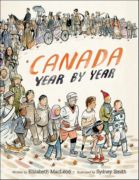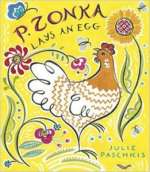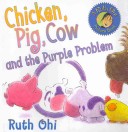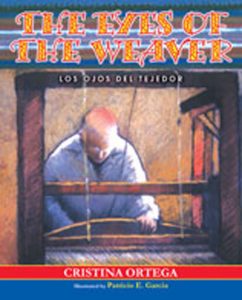
A unique look at Canadian history, Candad year by year captures these milestones and many more.

A unique look at Canadian history, Candad year by year captures these milestones and many more.

Extraordinary hen P. Zonka spends her time taking in the beauty around her: the shiny green of the grass, the buttery yellows of the dandelions, the deep blue of the sky. The other hens can’t understand why she never lays eggs like they do. Finally, P. Zonka gives in and lays an egg. To everyone’s delight, she produces a wondrous egg that contains all the colors and designs that she has stored in her creative imagination.

Florrie’s favorite coffee shop, with its open mike night, dreamy candles, and cute waiters … Going? The mysterious little hut selling fresh lemon ice on the west side of town … Going? The boutique featuring clothes you don’t find at the mall, allowing you to look like … an interesting person … Going? Individuality. Originality. Quality. Independence. Opportunity. Going, going, gone. What’s a girl to do?
See the review at WOW Review, Volume 3, Issue 4

Who ever heard of a purple cow?How come Cow’s spots are purple when every other cow’s are gray or brown? Fed up with being different, Cow sets out on a quest to change her spots.Thanks to a gravelly walkway, she soon finds lots of gray to cover the purple, and a squirrel in a tree provides plenty of brown by showering Cow with seeds. But when she arrives back home all big and bunchy and lumpy, Chicken and Pig hardly recognize her. When they finally realize it is Cow, they reassure her that she is their friend — purple spots and all.The adorable Chicken, Pig, Cow and Dog are back, and they continue to capture the hearts of young readers. The winning combination of simple text, expressive illustrations and lots of humor makes this a perfect choice for toddlers and beginning readers.
 Cristina Ortega is the granddaughter of Juan Melquiades Ortega, a master weaver of northern New Mexico’s Chimayó Valley. Chimayó’s roots are in early Spanish Colonial times and has long been famous for its unique weavings. Juan M. Ortega was taught to weave by his father in the early days when weavers sheared their own sheep and spun and dyed the wool for their blankets. El Tejedor (The Weaver) continued weaving until he was one hundred years old, when his eyesight failed him. In The Eyes of the Weaver, Cristina shares her memories of visits when she was ten years old with Grandpa in the village of Chimayó, where he taught her how to weave. She also recalls how Grandma helped her husband choose color combinations for his Chimayó blankets. It was during these visits that Cristina learned how important it is for a child to listen to and learn from his or her relatives.Some of Juan M. Ortega’s weavings and tools of the trade have been included in the exhibit, “American Encounters,” at the National Museum of American History, Smithsonian Institution, in Washington, D.C.Reading level: 10 years and up
Cristina Ortega is the granddaughter of Juan Melquiades Ortega, a master weaver of northern New Mexico’s Chimayó Valley. Chimayó’s roots are in early Spanish Colonial times and has long been famous for its unique weavings. Juan M. Ortega was taught to weave by his father in the early days when weavers sheared their own sheep and spun and dyed the wool for their blankets. El Tejedor (The Weaver) continued weaving until he was one hundred years old, when his eyesight failed him. In The Eyes of the Weaver, Cristina shares her memories of visits when she was ten years old with Grandpa in the village of Chimayó, where he taught her how to weave. She also recalls how Grandma helped her husband choose color combinations for his Chimayó blankets. It was during these visits that Cristina learned how important it is for a child to listen to and learn from his or her relatives.Some of Juan M. Ortega’s weavings and tools of the trade have been included in the exhibit, “American Encounters,” at the National Museum of American History, Smithsonian Institution, in Washington, D.C.Reading level: 10 years and up
Monique hates her school uniform. Who wants to wear brown and blue? Monique wants to be different. One day she finds a trunk filled with her mother’s old clothes, and the next day , and the day after that, and the day after that Monique transforms her boring old brown and blue, (and herself), until she finally learns that no matter what you wear, individuality always shines.